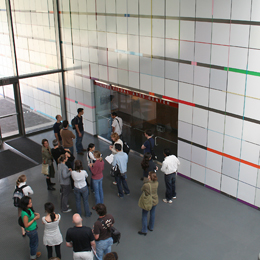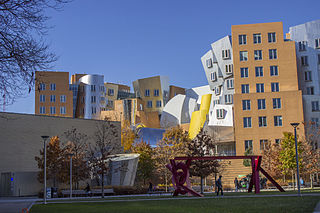
The Massachusetts Institute of Technology (MIT) is a private land-grant research university in Cambridge, Massachusetts. Established in 1861, MIT has played a significant role in the development of many areas of modern technology and science.

The Wiesner building houses the MIT Media Lab and the List Visual Arts Center and is named in honor of former MIT president Jerome Wiesner and his wife Laya. The building is very box-like, a motif that is consistently repeated in both the interior and exterior design evoking a sense of boxes packed within each other.
Massachusetts College of Art and Design, branded as MassArt, is a public college of visual and applied art in Boston, Massachusetts. Founded in 1873, it is one of the nation's oldest art schools, the only publicly funded independent art school in the United States, and was the first art college in the United States to grant an artistic degree. It is a member of the Colleges of the Fenway, and the ProArts Consortium.

The Cecil and Ida Green Building, also called the Green Building or Building 54, is an academic and research building at the Massachusetts Institute of Technology (MIT) in Cambridge, Massachusetts. The building houses the Department of Earth, Atmospheric, and Planetary Sciences (EAPS). It is one of the tallest buildings in Cambridge.
The MIT Program in Art, Culture and Technology (ACT) has its origins in the Center for Advanced Visual Studies (CAVS) at the Massachusetts Institute of Technology (MIT), an arts and research center founded in 1967 by artist and teacher György Kepes. In 2009, CAVS merged with the MIT Visual Arts Program, to become the MIT Program in Art, Culture and Technology (ACT). The Program is part of the MIT School of Architecture and Planning.
The MIT Museum, founded in 1971, is located at the Massachusetts Institute of Technology in Cambridge, Massachusetts. It hosts collections of holography, technology-related artworks, artificial intelligence, architecture, robotics, maritime history, and the history of MIT. Its holography collection of 1800 pieces is the largest in the world, though only a few selections from it are usually exhibited. As of 2023, works by the kinetic artist Arthur Ganson are the largest long-running displays. There is a regular program of temporary special exhibitions, often on the intersections of art and technology.

Otto Piene was a German-American artist specializing in kinetic and technology-based art, often working collaboratively. He lived and worked in Düsseldorf, Germany; Cambridge, Massachusetts; and Groton, Massachusetts.


The MIT School of Architecture and Planning is one of the five schools of the Massachusetts Institute of Technology, located in Cambridge, Massachusetts. Founded in 1865 by William Robert Ware, the school offered the first formal architectural curriculum in the United States and the first architecture program in the world operating within the establishment of a university. MIT SAP is considered a global academic leader in the design field and one of the most accomplished schools in the world. MIT's department of architecture has consistently ranked among the top architecture/built environment schools in the world and from 2015 to 2018 was ranked highest in the world in QS World University Rankings. In 2019, it was ranked second to The Bartlett but regained the number one position later on in the 2020 rankings.

Jack Wesley Burnham Jr. was an American writer and theorist of art and technology, who taught art history at Northwestern University and the University of Maryland. He is one of the main forces behind the emergence of systems art in the 1960s.

Established in 1950, the List Visual Arts Center (LVAC) is the contemporary art museum of the Massachusetts Institute of Technology. It is known for temporary exhibitions in its galleries located in the MIT Media Lab building, as well as its administration of the permanent art collection distributed throughout the university campus, faculty offices, and student housing.
Vera G. List was an American art collector and philanthropist. She was awarded a 1996 National Medal of Arts.

Jacqueline S. Casey was a graphic designer best known for the posters and other graphic art she created for the Massachusetts Institute of Technology (MIT). While practicing a functional Modernism, Jacqueline S. Casey was a graphic designer in the Office of Publications from 1955 to 1989, and was appointed director in 1972. In discussing her design, Casey stated, "My work combines two cultures: The American interest in visual metaphor on the one hand, and the Swiss fascination with planning, fastidiousness, and control over technical execution on the other."

Birth of the Muses is a 1944–1950 bronze sculpture by Jacques Lipchitz, installed on the Massachusetts Institute of Technology (MIT) campus, in Cambridge, Massachusetts, United States.

Aesop's Fables, II is a 2005 steel sculpture by Mark Di Suvero, installed on the Massachusetts Institute of Technology (MIT) campus, in Cambridge, Massachusetts, United States.

Elmo-MIT is a 1960s bronze sculpture by Dimitri Hadzi, installed on the Massachusetts Institute of Technology campus, in Cambridge, Massachusetts, United States.

La Grande Voile (The Big Sail) is a 1965 painted steel sculpture by Alexander Calder, installed in McDermott Court, on the Massachusetts Institute of Technology (MIT) campus, in Cambridge, Massachusetts, United States.

Transparent Horizon is a 1975 black Cor-ten steel sculpture by Louise Nevelson, installed on the Massachusetts Institute of Technology campus, in Cambridge, Massachusetts, United States. The artwork was among the first funded by MIT's "Percent-For-Art" program, which allocates $500,000 for art commissions for new architectural renovations on campus. The sculpture is an amalgam of two of Nevelson's previous works, Tropical Tree IV and Black Flower Series IV. The sculpture has been the target of vandalism.

Invaders is a 1981 sculpture by Gary Wiley, installed on the Massachusetts Institute of Technology (MIT) campus, in Cambridge, Massachusetts, United States.

















